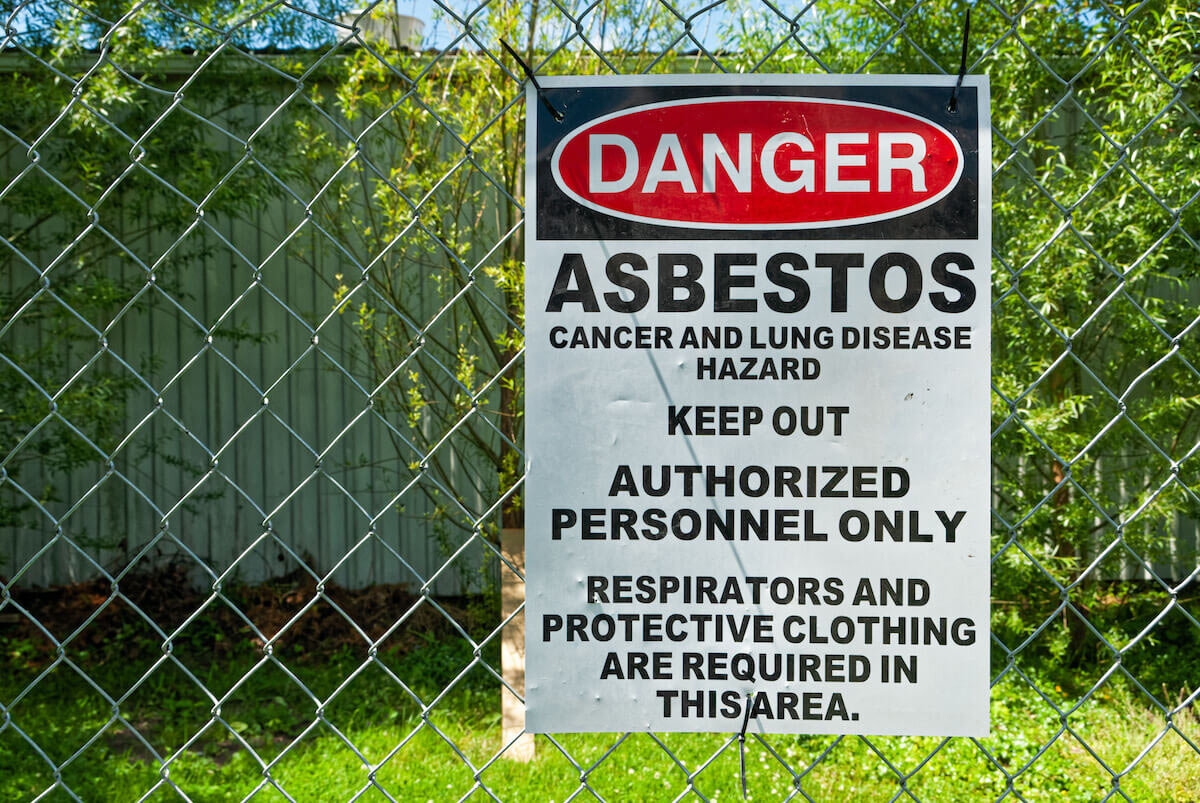 If you need to sell your home fast, “asbestos” is the last word you want to hear. It’s an incredibly hazardous material, so it can be daunting trying to figure out if you can sell a house with asbestos. Fortunately, we have all the information you need to navigate this tricky situation. Let’s take an in-depth look at asbestos, how to tell if your home contains it, and everything else involved in selling a home with asbestos.
If you need to sell your home fast, “asbestos” is the last word you want to hear. It’s an incredibly hazardous material, so it can be daunting trying to figure out if you can sell a house with asbestos. Fortunately, we have all the information you need to navigate this tricky situation. Let’s take an in-depth look at asbestos, how to tell if your home contains it, and everything else involved in selling a home with asbestos.
For informational purposes only. Always consult with a licensed real estate professional before proceeding with any real estate transaction.
Get a Cash Offer on Your Home With Cash Is King.
Want to skip the hassle of selling your home? We’ll make you a Guaranteed Cash offer. Get started now for free!
What Is Asbestos?
Asbestos is a material that we now know is linked to health problems, but was widely used in building homes until its dangers were discovered. From about the 1940s through the 1970s, it was considered an ideal material for insulation and fireproofing in homes due to its heat resistance and affordability. Unfortunately, even brief asbestos exposure can cause serious health issues such as mesothelioma, lung disease, and various types of cancer. Today, it’s illegal in many countries outside the U.S. to use asbestos in construction materials because of its potential risks, and its use within the U.S. is highly restricted.
If you own a home built in the 1980s or before, there’s a good chance your home has asbestos in it. An estimated 20% of public buildings in the U.S. have asbestos, and the percentage of residential buildings that contain asbestos is much higher. And while the mid-1900s was the height of asbestos use, it wasn’t the only time period to use asbestos, so you may find it in other homes, too.
Luckily, just because a house has asbestos in it doesn’t mean that it poses a health risk. Asbestos is only dangerous when “friable,” which means it could crumble or turn to powder if touched, releasing microscopic fibers into the air. Properly sealed asbestos in good condition isn’t dangerous, but it’s still important to know about it since it could deteriorate over time. It could also release asbestos if damaged during a renovation or demolition.
The best course of action when dealing with asbestos is to contact a certified asbestos professional who can assess the situation and advise on how best to proceed. If you suspect your house might contain asbestos, it’s important not to touch it at all until testing can be done. Investigating yourself could cause the asbestos to be disturbed and release its dangerous fibers.
How Can You Tell if Your House Has Asbestos?
Unfortunately, asbestos is difficult to identify with the naked eye because it has no defining visual characteristics. It comes in multiple colors, including blue, brown, gray, and white. It’s often mixed with other materials like cement. There isn’t even any smell, and there aren’t any immediate identifiable consequences of breathing it in. Testing it in a lab is the only way to definitively identify asbestos.
Asbestos has the potential to be found almost anywhere in the home. However, a few more common locations include:
- Insulation around pipes
- Cement boards behind tile, brick, or stone
- Siding
- Roof shingles and roofing felt
- Vermiculite insulation
- Textured paint
- Popcorn ceilings
- Drywall
- Some vinyl floor tiles
If you see something that could be asbestos, it’s best to call in an expert, just in case. Asbestos testing typically involves taking samples of suspected materials from the property to an accredited laboratory for analysis. The results will indicate whether or not asbestos is present and what type it is. While most homeowners opt for the cheaper DIY sample-taking route over hiring a professional to take the samples and send them off, this runs the risk of unnecessary exposure.
If any levels of friable asbestos are detected, it’s important to hire a professional to remove it safely to prevent health risks. Asbestos removal isn’t always necessary, though; if the material is undisturbed, it might even be safer to leave it alone. A professional can help you determine the best course of action.
Do You Have to Disclose Asbestos When Selling a House?
There isn’t a federal requirement to disclose asbestos, but if your state requires a seller’s disclosure, it’s almost certain that asbestos is listed on the form. Oregon is one such state, as the Oregon seller’s disclosure form asks “Has any portion of the property been tested or treated for asbestos, formaldehyde, radon gas, lead-based paint, mold, fuel or chemical storage tanks or contaminated soil or water?” Plus, there’s a catchall at the end for any other negative factor affecting the property.
If you know that there’s asbestos in the building, you’ll need to disclose the presence of asbestos to potential buyers.
Selling a House with Asbestos
When selling a house with asbestos present, it is important to understand all the options available. These include removing the asbestos, abating the asbestos, selling to a cash investor, or simply doing nothing. (Yes, doing nothing is sometimes an option.)
Removing and abating can be expensive and time-consuming processes, but it can also help increase the value of the property being sold. Selling for cash may be an appealing option as well, as this allows sellers to avoid any potential remediation costs associated with making the property safe. Ultimately, deciding what to do in this situation depends on each individual’s needs and circumstances.
Removing the Asbestos
If the asbestos in your home is damaged beyond repair, it’s dangerous, and the safest course of action is to remove it entirely. Removing asbestos from your home can be a costly process. Here’s what you’ll need to do:
- Hire a professional asbestos inspector to identify if, where, and to what extent asbestos is present.
- Hire a professional asbestos abatement team to safely remove and contain the asbestos. Doing the removal yourself should never be considered an option. The team will dispose of the asbestos in accordance with local laws and regulations at an approved disposal site.
- Finally, have an inspector come in to test and certify that all hazardous materials have been properly removed.
- If necessary, hire contractors to repair any damage caused by the removal process or perform renovations to meet up-to-date safety standards.
Asbestos removal can be completed within a day, but the testing periods before and after will take longer. An asbestos test can run anywhere from $200 to over $1,000, depending on where you live and local regulations, and removing asbestos has an average cost of about $2,000. Depending on where the asbestos is, it can cost between $5 and $20 per square foot. If you’re really unlucky and asbestos is present in the roof, walls, floor, pipes, attic, and more, full removal can cost upwards of $15,000!
Sometimes, however, it’s possible to save money and render the asbestos safe through encapsulation remediation and abatement, which is much cheaper.
Encapsulating the Asbestos
Asbestos encapsulation involves leaving undamaged or repairable asbestos in place and covering it in a high-grade protective sealant, usually polyurea. It’s the same process as encapsulating lead paint. This guards against it being disturbed and is usually highly effective, in addition to being more affordable than full removal. It may also be the safer option, as removal has more risk of causing the asbestos to become airborne.
This type of asbestos abatement is typically 15%–20% cheaper than full removal, around $2 to $6 per square foot. However, since the asbestos is still present, future renovation plans may still be affected.
Selling for Cash
Selling for cash can be a great way to quickly and cost-effectively sell an older home with asbestos. It’s an ideal solution when time is of the essence or if you want to avoid the hassle or expense of asbestos remediation.
Some benefits of getting a cash offer for a home that contains asbestos include:
- Cash transactions tend to close faster than traditional ones
- You can get a fair cash offer almost immediately
- There’s no need to get a lender’s approval for financing
- You don’t have to make any repairs due to the asbestos, saving money and time
- You don’t need to wait for a buyer who is willing and able to take on such a challenge–cash investors will take it off your hands as-is
With all these advantages, it’s easy to see why selling your house with asbestos problems for cash can be an attractive option.
Doing Nothing
If you choose to do nothing about the asbestos, you may be able to avoid costly repairs and save time on the sale. But it comes with tradeoffs—potential buyers will know about the asbestos and could either ask for a credit to fix it themselves or reduce their offer significantly. It may also take longer to get a buyer, since many buyers will avoid homes with asbestos.
Frequently Asked Questions
Is It Safe to Live in a House With Asbestos?
It largely depends on whether the asbestos is damaged or otherwise likely to become airborne. If you know or suspect your home has asbestos, it’s best to hire an expert for a professional evaluation. In some cases, the process of removing the asbestos may be riskier than leaving it be.
How Much Does It Cost to Remove Asbestos From a House?
Removing asbestos from a house can be costly. While it varies depending on the extent of the work required, on average, asbestos removal can cost around $2,000. If there isn’t much asbestos in your house, it may be cheaper. However, extensive asbestos removal can reach costs of around $15,000. Encapsulation is generally 15%–20% cheaper than removal.
How Does Asbestos Affect Home Value?
Asbestos can significantly reduce the value of a house, as it can pose health risks and is costly to remove. So if you’re selling, think twice before leaving it in!
Does Asbestos Need to Be Removed Before a House Can Be Sold?
While you must disclose the presence of asbestos to potential buyers, it’s legal to sell a home with asbestos. However, asbestos will likely reduce your final sale price, so weigh your options carefully.
Are There Any Laws That Govern the Sale of a House With Asbestos?
Abatement is not required to sell a home that contains asbestos, and there is no federal requirement to disclose the presence of asbestos before selling. However, you’re generally required to disclose the presence of asbestos by state and local laws.
For informational purposes only. Always consult with a licensed real estate professional before proceeding with any real estate transaction.
Asbestos in a Home? You Can Still Sell
When selling a home with asbestos, it’s important to be upfront about its presence. As long as the buyer is aware of any potential risks associated with it, the sale can still go through. While it may not be easy to sell a home with asbestos present on the traditional real estate market, it can still be done if both parties are informed and honest about what they’re getting into.
Get a Cash Offer On Your Home
No Commission. No Hassle. You pick the closing date.
CashIsKing.com works with cash investors on a daily basis and partners with investors who can deliver quick cash offers on properties of all conditions and locations. Why wait? Get a cash offer from an investor today!
Get a Cash Offer
